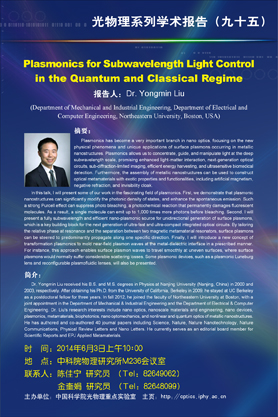题目:Plasmonics for Subwavelength Light Control in the Quantum and Classical Regime
报告人:Pro. Yongmin Liu(Department of Mechanical and Industrial Engineering, Department of Electrical and Computer Engineering,Northeastern University, Boston, USA)
摘要:
Plasmonics has become a very important branch in nano optics, focusing on the new physical phenomena and unique applications of surface plasmons occurring in metallic nanostructures. Plasmonics allows us to concentrate, guide, and manipulate light at the deep subwavelength scale, promising enhanced light-matter interaction, next-generation optical circuits, sub-diffraction-limited imaging, efficient energy harvesting, and ultrasensitive biomedical detection. Furthermore, the assembly of metallic nanostructures can be used to construct optical metamaterials with exotic properties and functionalities, including artificial magnetism, negative refraction, and invisibility cloak.
In this talk, I will present some of our work in the fascinating field of plasmonics. First, we demonstrate that plasmonic nanostructures can significantly modify the photonic density of states, and enhance the spontaneous emission. Such a strong Purcell effect can suppress photo bleaching, a photochemical reaction that permanently damages fluorescent molecules. As a result, a single molecule can emit up to 1,000 times more photons before bleaching. Second, I will present a fully subwavelength and efficient nano-plasmonic source for unidirectional generation of surface plasmons, which is a key building block for the next generation of ultra-fast and ultra-compact integrated optical circuits. By tailoring the relative phase at resonance and the separation between two magnetic metamaterial resonators, surface plasmons can be steered to predominantly propagate along one specific direction. Finally, I will introduce a new concept of transformation plasmonics to mold near-field plasmon waves at the metal-dielectric interface in a prescribed manner. For instance, this approach enables surface plasmon waves to travel smoothly at uneven surfaces, where surface plasmons would normally suffer considerable scattering losses. Some plasmonic devices, such as a plasmonic Luneburg lens and reconfigurable plasmofluidic lenses, will also be presented.
简介:
Pro. Yongmin Liu received his B.S. and M.S. degrees in Physics at Nanjing University (Nanjing, China) in 2000 and 2003, respectively. After obtaining his Ph.D. from the University of California, Berkeley in 2009, he stayed at UC Berkeley as a postdoctoral fellow for three years. In fall 2012, he joined the faculty of Northeastern University at Boston, with a joint appointment in the Department of Mechanical & Industrial Engineering and the Department of Electrical & Computer Engineering. Pro. Liu’s research interests include nano optics, nanoscale materials and engineering, nano devices, plasmonics, metamaterials, biophotonics, nano optomechanics, and nonlinear and quantum optics of metallic nanostructures. He has authored and co-authored 40 journal papers including Science, Nature, Nature Nanotechnology, Nature Communications, Physical Review Letters and Nano Letters. He currently serves as an editorial board member for Scientific Reports and EPJ Applied Metamaterials.
时间:2014年6月 3 日上午10:00
地点:中科院物理研究所M236会议室
联系人:陈佳宁 研究员 (Tel:82649062)
金奎娟 研究员 (Tel:82648099)
主办单位:中国科学院光物理重点实验室








